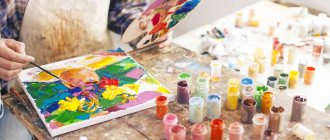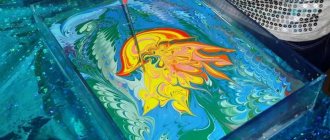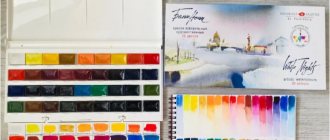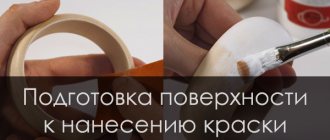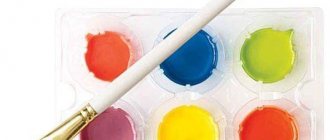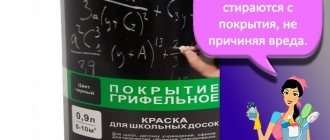Children of any age love to draw.
To apply images with brushes, paints and pencils to an album, you must have drawing skills, know the basic techniques and the correct use of various coloring agents.
If a child does not have the ability to draw, this may discourage him from creative pursuits, since the resulting ugly drawings do not resemble the images he expected.
What to do? The solution to the problem will be unusual drawing techniques, for example, “splashing”.
Materials and equipment
To perform work using the spray technique you need:
- paint (watercolor, gouache, oil, acrylic, etc.);
- thick paper or other base;
- water and container for it;
- brushes or toothbrush;
- stencils or templates;
- dried flowers, leaves, blades of grass;
- scissors, stationery knife;
- plastic ruler or comb;
- a simple pencil;
- apron, sleeves;
- oilcloth or newspaper;
- flat sticks and other devices.
How to avoid mistakes: expert advice
- Gypsum compounds are better suited for leveling foam concrete walls. When working with cementitious substances, it will be necessary to constantly moisten the surface.
- When choosing a plaster consistency, give preference to manufacturers who have proven themselves in the construction market: Knauf, Yunis, Volma, Starateli.
- You should not purchase compounds in countless quantities. To avoid fakes, it is better to first purchase one or two packages and check them. If the hardening time of the solution meets the standards, then the mixture can be used completely. Due to improper storage, plaster based on gypsum can set in 5-10 minutes, and cement compositions, due to non-compliance with proportions, will be able to flow down the wall.
- Ready-made consistencies of the highest quality are sold in three-layer packaging - two cardboard layers and one polyethylene layer.
- Spraying plaster with a compressor is a more optimal and easier way to apply decorative finishes. The surface is covered moderately, an interesting texture appears, and the size of the droplets can be adjusted by adding water.
- To apply decorative plaster by spraying, you need to select a special composition. The abundance of decorative coatings from foreign and Russian manufacturers will allow you to create a loft-style texture, popular bas-reliefs, roughness effects and imitation of various coatings.
Stages of creating images
First of all, you need to arrange your work space and put on an apron to protect your clothes. In order not to stain the ceiling, walls, table and other objects in the room, you should cover nearby surfaces with newspaper or oilcloth. The best solution would be to create drawings over the sink or bathtub, so that immediately after completing all manipulations you can wash your brushes, hands and dirty plumbing fixtures. You can take a large box in which you can also work with spray.
If you have no experience in working with this technique, you should first practice on rough sheets of paper. Creating splashes is very simple, but some practice is still needed.
In order to be more confident in getting a good result and not to worry that an annoying mistake will ruin the entire image, it is better to cover the surface to be decorated in advance with a layer of acrylic varnish. In this case, blots and unsightly strokes can be carefully wiped off with a damp paper towel or cloth.
The “spray” is created using a brush or toothbrush. The paint must be diluted with water in a separate jar or other container until the consistency of thin sour cream is obtained. The thicker the coloring composition is used in creativity, the more difficult it is to create splashes; they will be voluminous and embossed. However, too thin a consistency of the dye causes it to spread, which can cause large smudges or blots that will ruin the canvas.
Work in the spraying technique occurs in several successive stages:
- moisten a brush or toothbrush in water;
- shake off excess liquid to avoid blots;
- pick up a little coloring composition with a brush;
- take a brush or brush in your left hand, and a flat stick in your right;
- turn the bristles away from you, holding the devices over a sheet of paper, quickly run the stick along the surface of the hairs towards you so that the splashes fly onto the paper base of the future design;
- Depending on the task, spray the entire canvas or its individual sections with splashes of the desired shades.
While working with “spraying”, you can change the direction of your hand and spray paint horizontally, diagonally, etc. The size of the drops also changes - it can be adjusted by moving the bristles closer or further away from the paper sheet.
Paints of different colors and degrees of thickness will allow you to create unique images that cannot be recreated in exactly the same form. Smooth transitions from one color to another are an interesting idea when creating a unique piece.
Etching
Suitable for items of any size made of wood. Deciduous tree species lend themselves best to this processing method. In this way, you can give wood noble, rich shades without losing the natural beauty of the material’s texture.
Etching is carried out with various compositions - mordants. Some of them have complex names or a strong smell, but along with them there are many recipes available for making with your own hands, such as tea, coffee, compositions from leaves, bark; Potassium permanganate, blue, and vinegar are used. For those who feel like a bit of a chemist, tinting wooden surfaces is quite a suitable activity.
The process can happen in two ways:
1. Hand dyeing using a fiber-free cloth swab or a synthetic brush.
2. Dyeing by soaking in an etching composition.
Most often, the process takes place at elevated temperatures. After selecting and purchasing (mixing) the desired composition, the wood is cleaned of excess and sanded with sandpaper. Then there’s the etching-staining process itself. As a rule, the mordant recipe includes the time of exposure to the composition and the expected result. Basically, control is done visually and, of course, this is where creativity comes in.
Methods of using technology
There are many options for spray painting:
- using ready-made or self-made templates and stencils, dried flowers, leaves and other items;
- creating the effect of snow or rain, a sky strewn with stars, on a finished landscape image;
- to refine existing drawings and complement other techniques (for example, in decoupage);
- in order to create a basic background for a future painting for subsequent finishing of the painted surface;
- for tinting the base of applications;
- when making mats, etc.
Templates or stencils are often used in creativity because they do not require much artistic experience and knowledge. These devices are laid out on thick paper or another base, after which dye is sprayed on top. The stencil is removed, and a clear pattern of the selected shade remains on the paper web or a bright background is displayed. The same effect is achieved by using dried flowers, small twigs and other items that are easy to find on the street.
Home decor ideas
If you don’t know where to start and what you can choose for decoupage, we will look at a small selection of interesting items for decoration. We hope these creative ideas will inspire you to be creative and unique items of stunning beauty will appear in your home.
Just look how ordinary wooden hangers are transformed with the help of drawings on ordinary napkins. You can see step by step how to make decoupage on such a surface in the photo.
In addition, using decoupage, simple door handles can become an interesting art object that is sure to attract admiring glances.
A particular demand in decoupage is the decoration of furniture items. Just choose a plot whose theme will organically fit into your interior, and you will receive a beautiful and exclusive product. Photo ideas are presented below.
For particularly patient craftswomen, the decoupage technique can even be useful for decorating stairs.
On the eve of your favorite holidays, you can adopt ideas for decorating pumpkins or Easter eggs, which will not only decorate your home, but will also become a pleasant gift for family and friends.
Housewives will love decorative jars, buckets, boxes or flower pots. Just take a look around, almost any item you have at home can get a new life. A well-chosen picture will only add elegance to your interior and give it an individuality that is unique to you.
Plaster mortar - proportions
Plastering is an inseparable stage of surface treatment of walls and ceilings. Along with protective functions, it plays the role of decoration, increases fire resistance and is used as the main insulator. In addition, plaster makes it possible to remove minor imperfections on surfaces and connecting seams. The strength and fundamentality of the plaster layer mainly depends on the correct composition of the mixture.
Types of plastering solutions
Before preparing the plaster mixture, you need to know the microclimate of the room. Thus, for the treatment of external walls, a cement or cement-lime mixture is often used; if the climate is quite dry, then it is recommended to use plaster with the addition of lime for the treatment of external walls. But for moderate microclimates it is most often used for interior spaces.
Depending on the direction, plasters are divided into the following types:
- Cement. It is characterized by a slow increase in strength; the components set within 12 hours after adding water to the mixture. It is characterized by very high strength in comparison with other types of plasters.
- Clay. Used at home for plastering wooden surfaces.
- Limestone. To reduce the setting time and give the greatest strength, the lime plaster mixture is sometimes supplemented with building gypsum.
- Gypsum is also used separately. It must be remembered that complete hardening of the solution occurs after 30 minutes, and after 4 minutes setting occurs.
- In a mixed mortar for plastering surfaces, several binders are used (cement and lime, lime and gypsum, etc.).
- Special plaster. Depending on the application, the desired component is added to the mixture.
Sand is often used as a filler to prepare the solution. River sand is most suitable for making a mixture for plaster. Sea sand is characterized by excess salinity, which affects the strength of the mixture, and sand from ravines is, for the most part, very dirty
Composition and proportions of plaster
To make the mixture you need a binder, filler and water. In some cases, it is necessary to use additives to obtain a mixture of the desired qualities. For example, to obtain a water-repellent mixture, it is necessary to add calcium nitrate to standard parts of cement plaster.
Since plaster is often applied in 3 layers, the structure of the mixture is different for each layer. For spraying, a mixture with a low amount of binder is used, for the production of a primer layer, the amount of binder is slightly increased, and for the finishing layer, the maximum possible amount of binder is used. In this regard, the finishing layer is distinguished by increased strength.
When applying the plaster in one layer, it is advisable to use the average of the listed ratio of binder and filler. Otherwise, the mixture will not be soft enough and may come off the work surface.
In general, solutions for plastering surfaces have different compositions. So how to prepare a solution for plaster?
It is recommended to use the following proportions of mortar for plastering walls:
- Cement-lime mixture, for the production of one part of the volume of cement use: for spraying -0.3 - 0.5 parts of lime and 3 - 5 parts of filler, for the primer layer -0.7 - 1 part of lime and 2.5 - 4 parts of the filler, for the finishing layer the amount of lime is increased to 1 - 1.5 parts, the amount of sand is no more than 2.5 - 4 parts.
- The ratio of parts of the mixture for finishing surfaces using clay is constant for any layer - the filler is 3-5 times more than clay.
- Lime mortar for working with surfaces consists of: spraying from 2.5 to 4 parts of filler per 1 part of binder, a mixture for priming - from 2 to 3 shares, for finishing, add 1-2 parts of filler to 1 part of binder to the mixture.
- Lime-clay solution - 0.2 parts lime, 1 part clay and 3 - 5 parts sand.
- The composition of the cement-clay mortar must be the same for any layer - 1: 4: 6-12 (cement: clay: sand).
- Lime-gypsum mixture (lime: clay: sand), to 1 part of lime there is: spray -0.63-1 parts of clay and 2 - 3 parts of sand, a layer for primer - 0.5-1.5 parts of gypsum and 1, 5-2 parts of sand, finishing layer - 1 - 1.5 parts of gypsum (sand is not used in this option).
Types of plaster coatings
Plaster itself extremely rarely acts as a finishing material for walls. The main purpose of its application is to level the surface both in the general plane and to eliminate local defects, for example, seams and protrusions of brickwork. Following this principle, there are several types of plaster:
- Rough wiping (spraying) is used to improve adhesion between the outer finishing and load-bearing layer of the wall. In this way, surfaces are prepared for finishing, fixed with glue or cement mortar. A typical example is preparation for tiling.
- Soil casting without smoothing is used as a special case of the previous type, when there is a need to level out significant curvatures of the wall plane or straighten the geometry of the room.
- Finish plaster (covering) forms a perfectly flat surface with a minimum number of pores and defects. This method of rough finishing can be completed with wallpapering or puttying for painting.
Manufacturing of critical structures from shotcrete
In terms of reliability, the shotcrete method is not only not inferior, but also many times superior to traditional concreting in strength and strength. A particle of dry substance flies out of the nozzle at a speed of up to 250 m/s, the composition is compacted in a humid environment so strongly that the atomic forces of static tension come into play.
In the conditions of the test site of OJSC TsNIIS, 48 samples of shotcrete concrete were tested for strength using an IP-100 machine. Test results showed an average compressive strength of 40 to 70 MPa in tension and about 11.5 MPa in bending. Even vibrating concrete with very fine filler does not have such characteristics.
For comparison, the average compressive strength of control samples of concrete products used in road construction is about 36–47 MPa*, including products that have undergone post-treatment with sulfonation and calcination. Shotcrete also distinguished itself in terms of water absorption (up to 2%), water permeability (not lower than W12) and frost resistance in a wide range from F300 to F1000.
Only one conclusion can be drawn: technically, shotcrete is suitable for any known and many promising branches of residential or industrial construction.
* From the dissertation of Safina O. M. “Road vibro-pressed concrete products with increased performance characteristics.”
Dry method
It is considered traditional and was developed at the beginning of the 20th century. The method consists of separately supplying dry concrete mixture and water. The first is supplied to the mixer in the form of an air suspension (high density), and the second through a separate hose (from the tank). The substances are mixed directly during application to the surface, which ensures a high level of adhesion and tightness. The technology has obvious advantages:
- there is no need to prepare working surfaces (in particular, to prime them);
- the ability to adjust the intensity of the water supply (and the distance at which the stream will be supplied);
- ease of equipment maintenance.
Thus, the internal components of the shotcrete gun are not clogged with solution residues, and at the end of the work it is enough to clean only the mixer (rinse with water). Unfortunately, the method also has its disadvantages. We include:
- release of part of the solution beyond the working area (concrete splashes contaminate everything within a radius of 0.5-1.0 meters from the target);
- increased risks of injury (solid particles of the solution can bounce off the surface at high speed);
- the need for strict control over the proportions of the components (deviations to a smaller or larger direction significantly worsen the quality of concrete).
Types of cement-sand plaster
Despite the abundance of modern offers of dry mixes, cement-based compositions remain the most popular to this day. A layer of cement plaster performs aesthetic and sanitary functions, it is used to level surfaces, it protects walls from various types of damage, it is an excellent thermal insulator and absorbs noise well.
Based on their composition, solutions are divided into:
- cement-sand;
- cement-lime.
Watch how slopes are plastered with cement mortar; video tips will help you do the work yourself.
Cement-sand mortars
Cement-sand compositions are used for external and internal work, they are very durable, not afraid of moisture, temperature changes, durable, the only drawback is that the solution takes a long time to set and dry. The main element of the composition is cement - this is a binder, the brand of which determines the area of application of the plaster:
- M150-300 – interior decoration;
- M300 and more – facade work, open balconies, rooms with a difficult microclimate, for example, bathrooms.
Sand is the second important ingredient of the cement mixture, the quality of which determines the reliability and strength of the solution. It is recommended to use sand of medium fraction; small sand grains in the composition can lead to cracking of the plaster layer after drying; they are added to apply the last thin layer to obtain a smooth surface. Coarse sand is used only in facade finishing.
In industrial conditions, other components can be added to the finished cement-sand mortar to improve the characteristics of the composition. Additives such as redispersible polymers and copolymers increase the plasticity and strength of the solution, improve adhesive and hybrophobic properties, and frost resistance.
For a layer of cement plaster more than 50 mm, a reinforcing mesh will be required
Features of the cement-lime composition
Cement-lime plaster, according to regulations, is used only in rooms with a relative humidity of less than 65%. In addition to cement and sand, its composition includes slaked lime, which lightens the weight of the solution, gives it additional elasticity, it sets faster, and it is much easier to work with the mixture.
To prepare cement mortar with your own hands, the lime must be quenched and left for about 2 weeks. If you neglect these instructions, the quality of the plaster will significantly decrease; bubbles will appear during the work, which will lead to a violation of the integrity of the plaster layer. High-quality cement mortar with lime paste is vapor-permeable and durable.
Ready-made mixtures from manufacturers include the following components:
- Portland cement;
- slaked lime (hydrate);
- quartz sand;
- water retaining additives;
- polypropylene fiber.
Important: Some cement-lime mortars can be used for external plastering; usually the manufacturer indicates this specificity on the packaging.
When working with a dry composition, you must strictly adhere to the instructions, such as when there is excess water. The composition loses its strength characteristics and performance deteriorates.
Tools for cement plaster
Gypsum or cement plaster, which is better?
It is impossible to unequivocally answer which plaster is better, gypsum or cement; each type of mortar is applicable in its own conditions, and often both compositions are used in repairs. In addition, they share common characteristics:
- the mixed solution retains its qualities for up to 6 hours;
- frost-resistant;
- solutions can be applied at a temperature delta from +5 to 30 o C;
- You can putty and paint plastered surfaces after 2 weeks;
- after 3 days the layer of plaster can withstand the gluing of tiles;
- It is recommended to store the dry mixture for no more than 1 year, in a tightly closed container, in a dry place.
To decide which is better suited, gypsum or cement plaster, you should evaluate the area of work, the operating conditions of the surfaces, and the purposes for which the surface is being leveled. Thus, it is believed that it is better to choose a gypsum composition for wallpapering and painting, and a cement composition for tiling in rooms with high humidity.
The solution should be thick and stick to the trowel
Principle of operation
I would like to clarify right away that the term “airless” is conditional, since the spraying of paint on the surface occurs due to hydraulic pressure, which helps to displace the mixture at high speed. The coating material is supplied to the base through an elliptical nozzle.
Painting in this way allows you to create a high-quality and even film on surfaces. How to make a spray bottle for whitewashing with your own hands? If we compare the pneumatic method and the airless painting option, the second method allows you to significantly save paint and varnish materials. Airless spraying has some advantages:
Before you start painting products and surfaces with your own hands, you also need to familiarize yourself with the disadvantages that the airless spray option has:
- It is better not to use for small objects, since a large amount of paint comes out through the nozzle and the consumption increases.
- It is impossible to regulate the flow rate and width of the torch
- The devices cannot create such high-quality surfaces as pneumatic spraying. According to the data, the painted surface has class 3-4 according to GOST 9.032-74
- It is better not to use for surfaces where frequent replacement of the paint coating is necessary.
Important! Based on these data, I realized that airless painting is used more for industrial purposes, where it is necessary to spray paint over a large area or metal structure. For domestic purposes it will be much more convenient to use other methods
